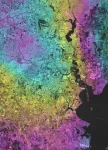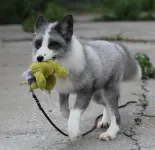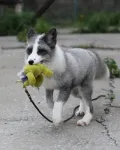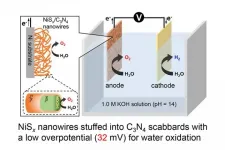(Press-News.org) The types of land around us play an important role in how major storms will unfold -- flood waters may travel differently over rural versus urban areas, for example. However, it's challenging to get an accurate picture of land types using only satellite image data because it is so difficult to interpret.
Researchers at the Cockrell School of Engineering have, for the first time, applied a machine learning algorithm to measure the surface roughness of different types of land with a high level of detail. The team used a type of satellite imagery that is more dependable and easier to capture than typical optical photographs but also more challenging to analyze. And they are working to integrate this data into storm surge models to give a clearer picture of what will happen during major weather events.
"You can imagine that when a storm approaches land it will move much faster and farther over open or barren land," said Ke Wang, a graduate researcher in the lab of Ann Chen, assistant professor in the Department of Aerospace Engineering and Engineering Mechanics. "And, in contrast, storms move slower over rougher surfaces like densely vegetated forests."
Today, the main source for data about land types comes from the National Oceanic and Atmospheric Administration. But that data is only updated every five or six years, making it hard to get a clear picture of how the land changes over time. The researchers aim to make their land data capable of at least annual updates and, ideally, more frequent than that.
For their experiment, the team analyzed publicly available Synthetic Aperture Radar, or SAR, images taken from a Japanese satellite. SAR images are different from the powerful cameras in other satellites because they actively illuminate the ground using radar signals rather than relying on light from the sun, which may be limited at night or when cloud cover is present.
Standard, physics-based models have struggled to accurately analyze these types of images. But the team's machine learning algorithm was able to create a clear enough picture of land roughness data that the information could be used in storm surge modeling.
Using these publicly available satellite images, the algorithm automatically classifies different types of land by analyzing characteristics such as topography and brightness from the satellite data. The research primarily focused on areas along the Gulf Coast around New Orleans and Houston, where rapid land changes and increases in strong storms put these major cities more at risk for significant damage.
The team is working with Clint Dawson, professor and chair of the Department of Aerospace Engineering and Engineering Mechanics and leader of the Oden Institute's Computational Hydraulics Group, to adapt the data for his storm surge models.
"Storm surge is a competition between wind pushing water towards the coast, and the coast's ability to withstand the force of the surge," Dawson said. "There is a big difference in storm surge when the coast is covered with flexible grass versus thick trees such as mangroves. The Texas coast is particularly vulnerable to surge because it is primarily low-lying marshland and prairie. Therefore, knowing the type of land cover in a coastal region is essential to being able to mitigate and predict storms surge."
This data could help decision-makers contemplating methods to blunt the impact of storms, said Chen, who is the principal investigator on the paper published in IEEE Transactions on Geoscience and Remote Sensing. For example, policymakers have long debated the possibility of building "green walls" of vegetation to protect inland areas from hurricanes and other potentially dangerous storms. This information could help figure out the best places to put these green walls to protect vulnerable areas.
Though this research is mostly focused on storm surge models, there are a number of other applications. It could be used to look at forests and classify trees to understand how much potential wood supply exists and impacts of timber harvesting. And it could someday help track how land changes over time, whether due to things like deforestation, urban development or sea level rise.
But that would require improvements in satellite data. The researchers' algorithm needs approximately 10 images to make an accurate characterization of land. If it took a year to get those 10 images, it could tell what type of land is in that place, but it could not analyze how the land changed throughout the year. However, NASA is in the midst of a program to update and upgrade satellites needed to capture these images. They will collect data more regularly at a higher resolution.
"The space image data we have now is a lot more than we had 10 years ago," Chen said. "And in the next 10 years, with the quality and quantity of the data we are going to have, it's going to be a time of exponential growth."
INFORMATION:
Both during and after infection with the Coronavirus SARS-CoV-2, patients may suffer from severe neurological symptoms, including "anosmia", the loss of taste and smell typically associated with COVID-19. Along with direct damage caused by the virus, researchers suspect a role for excessive inflammatory responses in the disease. A team of researchers from the Freiburg University Medical Center and the Cluster of Excellence CIBSS has now shown that a severe inflammatory response can develop in the central nervous system of COVID-19 patients involving different immune cells around the vascular ...
Dr Sebastian Hess and his team at the University of Cologne's Institute of Zoology have studied a very rare and puzzling tripartite symbiosis. This consortium consists of a ciliate as host and two types of endosymbionts: a green alga and a previously unknown purple bacterium. Through genetic analyses of the pink-green ciliate, the researchers discovered that the endosymbiotic bacterium belongs to the so-called 'purple sulfur bacteria' (family Chromatiaceae), but has lost the ability to oxidize reduced sulfur compounds, a hallmark of the other members of the Chromatiaceae. The genome of the purple bacterium is greatly reduced, suggesting that the bacterium became mainly specialized in carbon fixation through photosynthesis. It is probably no longer able to live outside of the host cell. Thus, ...
Boston - Hypertension, or high blood pressure, kills more Americans than any other health condition. It is especially prevalent in Black Americans and is exacerbated by structural barriers to accessing high quality healthcare. In a 2018 randomized trial called the Los Angeles Barbershop Blood Pressure Study (LABBS), barbers were trained to screen their Black male patrons for hypertension and refer them to a pharmacist who visited the barbershop to counsel and treat individuals with high blood pressure. Participants in the barbershop-based, pharmacist-led program saw a 20-point drop in systolic (top number) blood pressure that they were able to sustain ...
An international research team led by Professor Dr Frank Schäbitz has published a climate reconstruction of the last 200,000 years for Ethiopia. This means that high-resolution data are now available for the period when early Homo sapiens, our ancestors, made their way from Africa to Europe and Asia. Schäbitz and his colleagues determined the dates using a drill core of lake sediments deposited in southern Ethiopia's Chew Bahir Basin, which lies near human fossil sites. Temporal resolution of the samples, reaching nearly 10 years, revealed that from 200,000 to 125,000 years before our ...
Does evolution explain why we can't resist a salty chip? Researchers at NC State University found that differences between the elemental composition of foods and the elemental needs of animals can explain the development of pleasing tastes like salty, umami and sweet.
Taste tells us a lot about foods before they are swallowed and digested, and some tastes correspond with the elemental composition of foods. For example, an aged steak lights up the umami taste receptors, because it has a high concentration of the element nitrogen, which occurs in amino acid molecules. Nitrogen is essential for survival, but often occurs in low concentrations relative ...
(Boston)-- The concept of rationing medical resources during the height of COVID-19 pandemic created tremendous anxiety in the patient and healthcare communities. In planning for that possibility Massachusetts created a triage scoring system focusing on an acute survival score that considers chronic life-limiting medical conditions of the patient, but it does not provide specifics about how to value those conditions in the equation.
Now a new study supports prioritizing resources to those who are most likely to survive an acute illness as several chronic medical conditions had less of an impact on longer-term survival than previously suspected.
"No one ...
(Boston)--Despite evidence regarding the benefits of vaginal birth after cesarean and recommendations to support shared decision making to reduce cesarean rates, minority women face many impediments that limit their access to appropriate health information and opportunities for such discussions.
Haitian women in Massachusetts have the highest rates of cesarean section and low rates of vaginal birth after cesarean, despite evidence suggesting that many are eligible to attempt vaginal birth after a previous cesarean.
Now a new study explores how Haitian women's beliefs, values and attitudes influence their decision making about pregnancy and birth after having had a cesarean delivery. In conjunction with the providers' views about Haitian women, the information ...
Farmed foxes selectively bred for tameness and aggressiveness exhibit similar changes to their brain anatomy, according to research recently published in JNeurosci. Both lineages also have larger brains than conventional farm-bred foxes, complicating leading theories on domestication.
Domesticated species provide insight into complex evolutionary processes on a condensed timeframe. When a species splits from its wild counterpart, its brain, body, and behavior undergo rapid changes. Studies with chickens, sheep, cats, dogs, and more indicate domestication shrinks the brain. But the same pattern does not extend to foxes in the expected way.
Hecht et al. used MRI to measure the brain size ...
When Erin Hecht was earning her Ph.D. in neuroscience more than a decade ago, she watched a nature special on the Russian farm-fox experiment, one of the best-known studies on animal domestication.
The study, running since 1958, tries to replicate the natural domestication of wolves to dogs by selectively breeding two strains of silver foxes so they exhibit certain behaviors. Scientists breed one to be tame and display dog-like behaviors with people, such as licking and tail wagging. The other is bred to react with defensive aggression when faced with human contact, while a third strain acts as the control and isn't bred for any specific behaviors.
Hecht, who's now an assistant professor in the Harvard Department of Human ...
Niigata, Japan - In the recent past, there has been a paradigm shift towards renewable sources of energy in order to address the concerns pertaining to environmental degradation and dwindling fossil fuels. A variety of alternative green energy sources such as solar, wind, hydrothermal, tidal etc., have been gaining attention to reduce the global carbon footprints. One of the key challenges with these energy generation technologies is that they are intermittent and are not continuously available.
"We cannot use solar energy at night and wind energy when the wind is not blowing. But we can store the generated electricity in some other forms and utilize it whenever required. That is how water splitting bridges the gap and has emerged as a very promising energy storage ...



